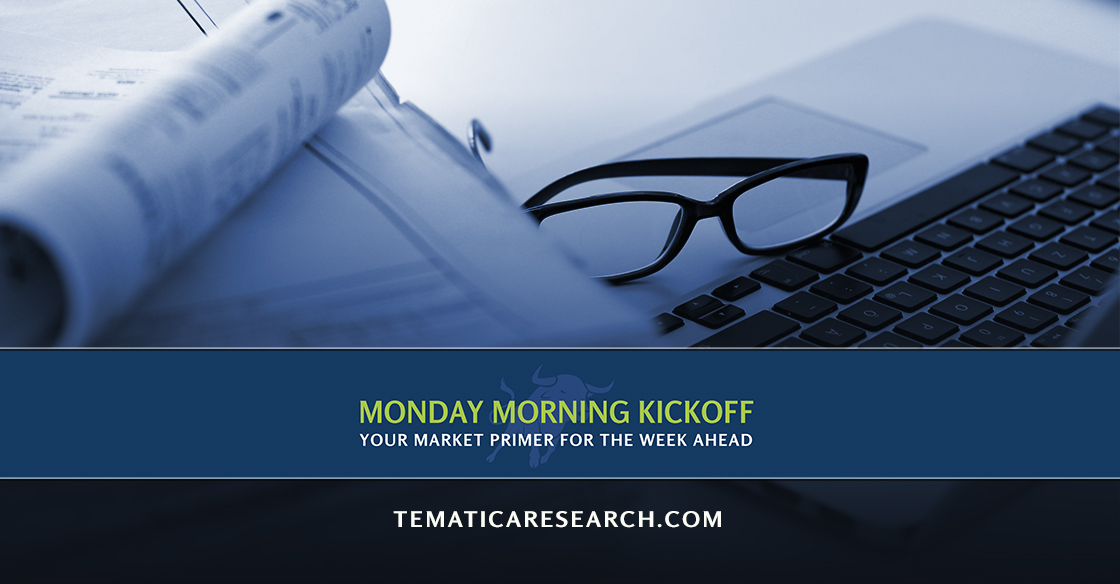Growing mismatch between Stock Market expectations and a thing called Reality
DOWNLOAD THIS WEEK’S ISSUE
The full content of The Monday Morning Kickoff is below; however downloading the full issue provides detailed performance tables and charts. Click here to download.
Last week closed the books on November, and what a month it was! The most widely used index for the investment community, the S&P 500, rose 3.4 percent during the month, while the industrial and financial heavy Dow Jones Industrial Average rose 5.4 percent. Both were overshadowed by the 11 percent move by the small cap heavy Russell 2000. Even after the market declines toward the end of last week, those major market indices were still up substantially over the last 5 weeks.
Part of that market move was the post-election rally — referred to as everything from the Trump Bump to the Trump Trade to the Trump Rally — which has led to a market rotation favoring sectors of the economy that are expected to prosper under President-elect Trump should we see the promised tax cuts, reduced regulations, infrastructure spending and investment the US military. We’re talking about financials, construction, materials and defense-related companies.
In our view, the market’s recent surge, while welcome, is likely outpacing near-term economic reality. During the first two months of the fourth quarter, Fact Set found analysts lowered earnings estimates for companies in the S&P 500 for the current quarter to $30.91 from $31.55. That means earnings growth expectations are not only 2 percent softer than before but on a quarter over quarter basis it equates to an earnings decline from the $31.36 in EPS generated by the S&P 500 during the September quarter.
Not only is GDP in the current quarter expected to drop to 2.1-2.3 percent from 3Q 2016’s 3.2 percent, but the current view on GDP in 2017 sits around 2.2 percent with the first half of next year coming in a tad shy of that level. Odds are the vast majority of the initial bout of Trumponomics won’t be felt until the second half of 2017.
The bottom line is November was a barn burner for stocks, so much so that it left several market indices in overbought territory, leading to a rebound in the Volatility index, better known as the VIX. The next move in the market is likely to be sideways, but we could see it give back some of its recent gains as investors, analysts and economists puzzle through the potential impact of President-elect Trump’s policies and economic initiatives vs. when they will have a stimulative effect on the economy. Additionally, a “no” vote for the Italian referendum — which we cover in detail further down — could be the catalyst that takes some of the current forth out of the stock market.
Historically, the forward-looking market has a habit of getting ahead of itself, which means eventually market expectations and economic reality will converge. As that happens, odds are we’ll get better stock prices than we have today, but with the underlying companies facing more favorable growth prospects over the medium term should President-elect Trump’s policies have the expected impact in 2017 and beyond.
The Economy on Firm Footing . . .for now
Lending a helping hand to the market rally to record levels was last week’s economic data, which painted a picture of an economic landscape that is on far firmer footing than in recent months:
- The second estimate for 3Q 2016 GDP was revised upward to 3.2 percent from the prior 2.9 percent;
- The November ADP Employment Change Report killed it with 216K new jobs in November vs. the expectated 160K. That beat, however, was softened by the prior two months’ downward revisions, which kept the 3-month moving average little changed.
- October Personal Income & Spending saw better disposable income, but spending was hampered by one of the highest savings rates we’ve seen in 2016.
- The November ISM Manufacturing Index marked the third month of expansion, with the highest reading since June) and several takes on November job creation (inline to a strong private sector, but people still falling out of the labor force big time)
- The Fed’s latest Beige Book was a mixed bag however. On one had it showed “the economy continued to expand across most regions from early October through mid-November.” On the other hand, it also called out the strong US dollar as a “headwind to more robust demand.”
Oil — a Second Headwind for the Economy
The Fed Beige Book report mentioned earlier also pointed out that the announced oil production cuts from the latest OPEC meeting that sent oil prices gapping up serve as a second headwind to the domestic economy. Consumers have been enjoyed a 10 percent drop in average gas prices since mid-June that the recent surge in oil prices is likely to erase.
The silver lining to be had should those production cuts hold and oil prices trend higher is the potential for more idled US offshore oil rigs and shale production facilities to come back on stream, generation good paying jobs in the process.
November Employment Situation Report
Friday’s November Employment Situation report was the last Employment Report we’ll receive before the Fed’s next FOMC meeting. For the most part it was as expected. Headline total nonfarm jobs came in at 179,000 for the month, a smidgen below the consensus expectation of 180,000, and up from 142,000 in October. That headline figure kept average job growth year-to-date at 180,000 per month. Paired with year over year wage gains of 2.5% in November and a relatively stable November labor force participation rate at 62.7, odds are the Fed will overlook the bad math drop in the November Unemployment Rate as it eyes that increasingly likely Fed rate hike in the coming weeks.
The big surprise in the report was the 4.6 percent unemployment rate, a relatively sharp drop from the 4.9 to 5.0 percent range in September in October. Peering into the data shows something different from the “as expected” results associated with the headline November jobs figure. Let’s go the data:
- The November civilian labor force was 159.5 million, down from 159.7 million in October;
- The number of Employed rose to 152.085 million, up from 151.925 million in October;
- The number of Unemployed fell to 7.4 million from 7.79 million in October;
- The number of people not in the labor force rose to 95.05 million, up from 94.6 million in October 2016, and 94.4 million in November 2015.
Putting this together, we see the primary reason behind the fall off in the November Employment Rate was really the number of people falling out of the labor force (0.45 million), not the month over month gain in the number of employed additions (0.16 million).
Not quite the picture one would think given the positive tone of the week’s economic data. Again, when we tally up the week’s data and looks at the various puts and takes, it looks increasingly like a Fed rate hike is in the offing near-term.
Italy’s Complex Choice
Sunday, December 4th was the referendum vote in Italy. Tematica’s Chief Macro Strategist Lenore Hawkins and Chief Investment Officer Chris Versace shared their thoughts on this issue here, but like most other voting events, there tends to be a final outcome, which most likely won’t be known until late Monday at the soonest. With that in mind, here are the likely scenarios:
- If contrary to the polls the “yes” vote wins, Italian bonds and banks will rally and the MIB (Italian stock index) will have a huge relief rally, particularly given its over-exposure to banks, and the euro will likely strengthen relative to other currencies.
- If the polls are right and we see a “no” vote by a large margin, Italian yield spreads over German bunds will widen a lot. Italian bank stocks will accelerate downward and Banca Monte dei Paschi di Siena (MPS) will likely need external aid, which will put the European Central Bank in the hot seat, and all eyes will be on German Chancellor Angela Merkel who is also watching Germany’s Deutsche Bank spiraling downward.
This Week’s Economic Data Front
Following the data-heavy week we’ve just had, the coming week is far tamer on the flow of economic data points coming at us. With more than a week to go until the Fed’s next FOMC Meeting (Dec. 13-14), and data received over the past week likely cementing the prospects for the Fed to boost rates exiting that meeting, we’ll continue to put the November ISM Services, 3Q 2016 Productivity, and Unit Labor Cost data through its paces.
Much like the November Employment Report, unless there is a wide miss relative to expectations that causes a major re-think on the economy, the odds are rather high the Fed will boost interest rates come Dec 14.
Earnings On Tap this Week
In the coming week, four S&P 500 companies are slated to report results for 3Q 2016 and two scheduled to report their results for 4Q 2016. Given our thematic perspective that shuns the sector based herd view, we’ll be focusing on the thematic data points to be had coming out of earnings results from:
Autozone (AZO), Costco Wholesale (COST), and Ollie’s Bargain Outlet Holdings (OLLI) for Cash-strapped Consumers;
Adobe Systems (ADBE), Broadcom Ltd. (AVGO) and Liberty Broadband (LBRDA) for lies ahead in our Connected Society;
Match up demand drivers for Hostess Brands (TWNK) vs. Hain Celestial (HAIN) and United Natural Foods (UNFI) as Fattening of the Population squares off against Food with Integrity.
Get a sense where Rise & Fall of the Middle-Class consumers are spending that higher October disposable income when we hear from Toll Brothers (TOLL), Lululemon Athletica (LULU), and Virgin America (VA).
As we fold those results and company comments into our thematic investing lens, we’ll be assessing how much potential upside vs. downside is left in the stock market near-term.




